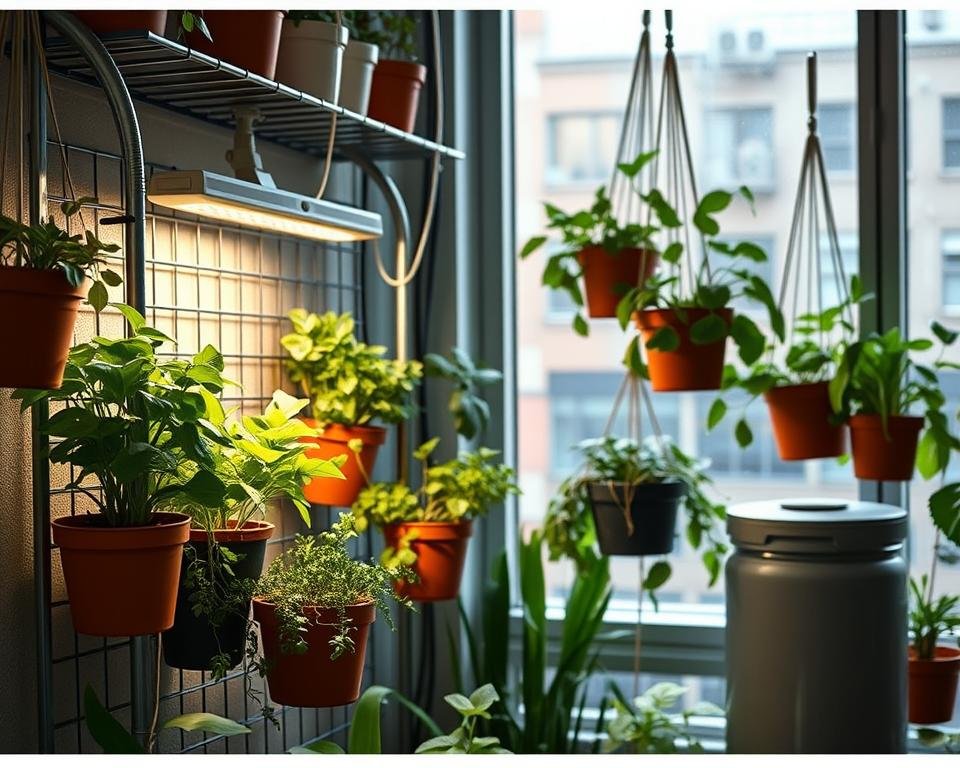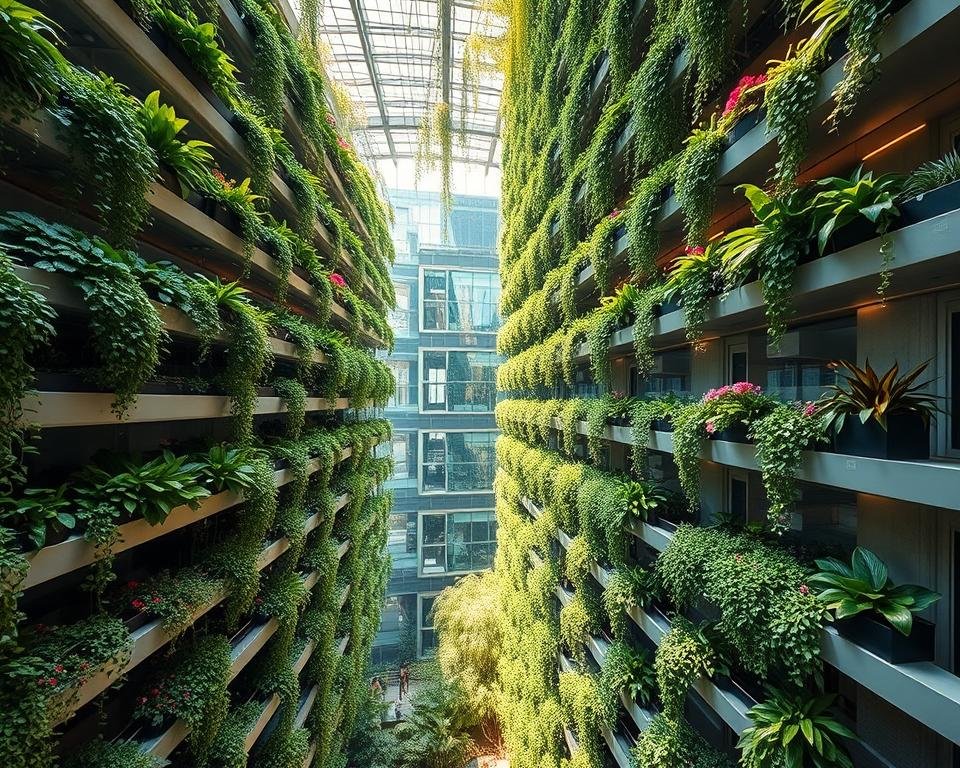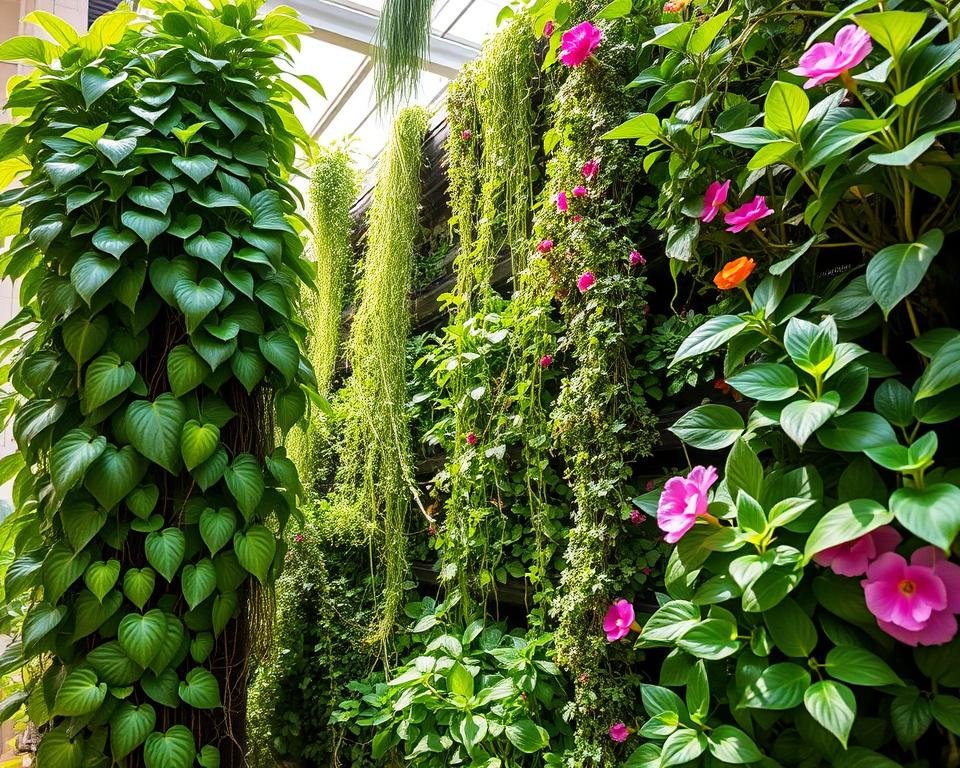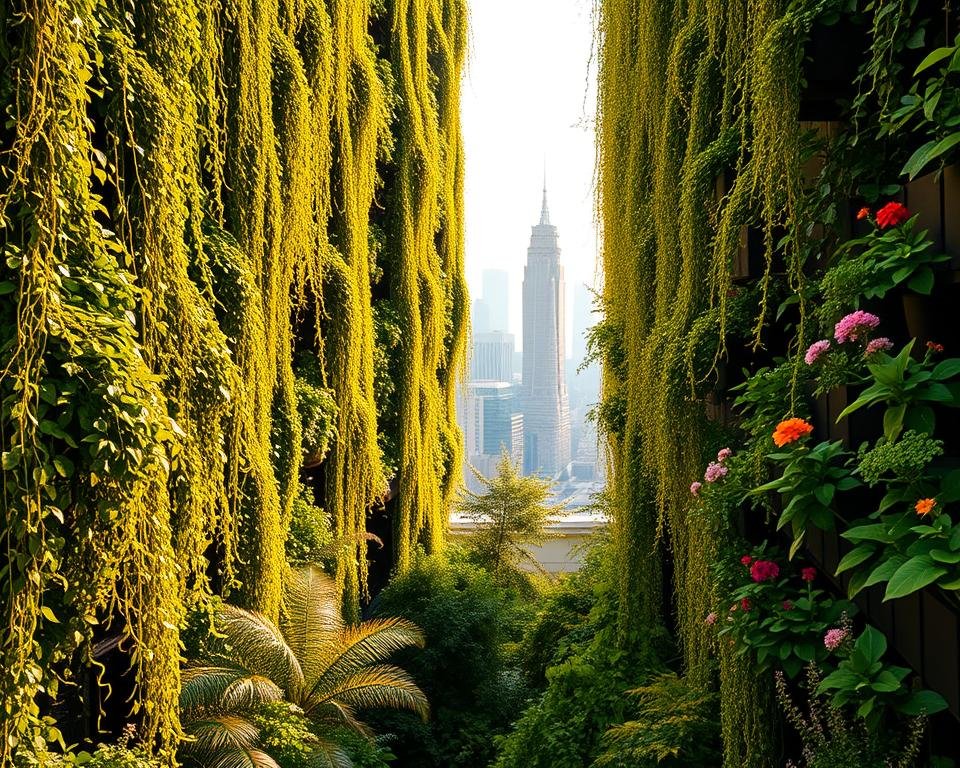Creating an Urban Oasis with Vertical Gardening
Imagine turning your small city balcony into a lush, green paradise. Urban gardening has changed how city folks connect with nature. Vertical gardens are the best way to make stunning green spots in tight spaces.
Vertical gardening is more than a trend. It’s a lifeline for city folks who love natural beauty. These gardens use up to 80% of vertical surfaces. They turn blank walls and small areas into amazing green views that make cities feel alive.
Your urban oasis is more than a garden. It’s a personal escape that cools city temperatures, saves water, and brings nature right to your home. Whether you have a tiny balcony or a small patio, vertical gardens let you dream up new city gardens.
Key Takeaways
- Vertical-gardens maximize limited urban spaces
- Reduce ambient temperatures by up to 5°F
- Save approximately 30% on water usage
- Create personal green-spaces in compact areas
- Transform urban environments with innovative gardening techniques
Understanding Vertical Gardens and Their Urban Impact
Urban-greenery is changing cityscapes, with vertical gardens leading the way. These living walls do more than look good—they’re key to making cities greener. They bring life to the concrete jungles we call cities.
Vertical gardens are a new way to add nature to cities. They use space wisely, offering many benefits for both people and the environment.
The Evolution of Green Walls
Vertical gardens have come a long way, from ancient wonders to today’s architectural feats. Cities around the world are using these green technologies to tackle urban problems:
- Space optimization in crowded areas
- Improved air quality through natural filters
- Less heat in cities
Benefits for City Dwellers
Vertical gardens offer many perks for city folks:
- Improved mental health from more green-spaces
- Less noise
- Natural cooling
Environmental Impact in Urban Spaces
Vertical gardens are eco-friendly wonders. They support wildlife, clean the air, and create homes for urban animals. By 2050, they’ll be vital for making cities sustainable.
Vertical gardens are not just design elements—they’re urban ecosystem solutions.
Places like One Central Park in Sydney and Bosco Verticale in Milan show what vertical gardens can do. They’re changing city views with thousands of plants and trees.
Essential Components for Your Vertical Garden Setup

Creating a successful vertical-garden needs careful planning and the right tools. Urban folks can turn small spaces into lively green spots. They do this by picking the right containers and support systems that use every inch of space.
When setting up your vertical-garden for eco-friendly cities, remember these key parts:
- Structural Support Systems
- Wall-mounted planters
- Freestanding vertical frames
- Trellises and hanging structures
- Container Options
- Felt pocket planters
- Modular grid systems
- Stackable plant containers
Your vertical garden’s success depends on the right containers. Shallow-rooted plants like herbs, succulents, and trailing vines work best in these compact systems. Think about sunlight, how much your walls can hold, and the system’s strength before you start.
Modern vertical gardening solutions are very flexible. DIY fans can make their own frames from wood or metal. Beginners might like ready-made systems found online. No matter what, choose something sturdy and good for plants to make a lush urban oasis.
Pro Tip: Invest in high-quality, well-drained potting soil and consider self-watering systems. This makes caring for your vertical-garden easier and helps it thrive over time.
Building Your Urban Oasis: Getting Started
Turning your city spot into a peaceful oasis needs planning and design. A vertical-garden is a great way to add nature to your urban area. It offers a cool break from the city’s noise.

Starting your green sanctuary journey means getting ready and picking important items. These will help your vertical-garden thrive.
Selecting the Perfect Location
Finding the right spot for your oasis is key. Think about these things:
- Sunlight all day
- Shield from strong winds
- Easy access for upkeep
- Wall or surface support
Choosing Container Systems
Picking the right containers is vital. Look for ones that:
- Drain well
- Help roots grow
- Look good in your space
- Make it easy to swap out plants
Small pots dry out fast, so pick bigger ones. Use a 2:1 mix of peat-free soil to multipurpose compost. Make sure there’s a 3-5 cm gap at the top for water.
Installing Support Structures
Sturdy support is crucial for your garden’s stability. Make sure your system can handle the weight of plants, soil, and water. You can use wall frames, freestanding trellises, or modular systems to create your oasis.
By picking the right spot, containers, and support, you’re on your way to a lush oasis in the city.
Plant Selection for Vertical Success

Starting a vertical-garden means picking the right plants. Urban gardeners can turn small spots into green oases. They do this by choosing plants that grow well in vertical spaces.
When planning your rooftop farm or urban garden, think about these plant types:
- Herbs: Compact and versatile options like mint, cilantro, and oregano
- Succulents: Low-maintenance plants perfect for vertical structures
- Climbing plants: Jasmine and ivy for privacy and aesthetic appeal
- Edible crops: Tomatoes, peppers, and lettuce for urban agriculture
Indoor vertical gardens do well with plants that handle little light. Snake plants, pothos, and peace lilies are great for low-light areas. They make your space look better and clean the air.
When picking plants, remember:
- Light needs
- Water needs
- Growth potential
- Weight and support needs
Pro tip: Use hydroponic systems for growing herbs and veggies all year. These systems boost your garden’s output with less work.
Urban gardening turns small areas into lively, green spaces that feed both body and soul.
Smart Irrigation and Maintenance Systems
Creating a thriving vertical garden needs smart water management. It supports sustainable urbanism. Your urban green space needs a careful irrigation approach. This approach should keep plants healthy and use less water.
Smart irrigation systems can cut water use by up to 50%. Drip irrigation techniques deliver water right to the roots. This helps eco-friendly cities and saves water.
Water Management Solutions
Choose an irrigation system that fits your vertical garden’s needs. Here are some efficient options:
- Drip irrigation systems with targeted root-level watering
- Smart controllers with moisture sensors
- Rain sensor-equipped systems
- Mobile app-controlled irrigation platforms
Seasonal Care Requirements
Change your irrigation plan with the seasons to keep plants healthy. Key seasonal tips include:
- Spring: Gradually increase watering as plants emerge
- Summer: Implement deeper, less frequent watering
- Fall: Reduce watering frequency
- Winter: Minimize watering, protect sensitive components
Troubleshooting Common Issues
Keep your vertical garden’s irrigation system in top shape. Watch out for these common problems:
- Clogged emitters: Clean filters regularly
- Uneven water distribution: Check and adjust system pressure
- Leaks: Inspect tubing and connections monthly
By using these smart irrigation methods, you’ll have a water-efficient vertical garden. It will help make cities greener, use less water, and keep plants looking great.
Designing for Maximum Visual Impact
Turn your city garden into stunning vertical landscapes that show off biophilic design. Your urban area can become a living work of art. It not only makes your space look better but also connects you with nature. Vertical gardening techniques are a smart way to make a big impact in small spaces.
To make a beautiful vertical-garden, you need to plan carefully. Think about these important design parts:
- Use different plant textures and colors
- Make layers for depth
- Pick plants that grow well together
- Add architectural features
Vertical gardens can add up to 30% more space. They’re perfect for city folks wanting to use their outdoor areas better. By arranging plants smartly, you can turn blank walls into lively green walls.
Design is not just about looks, but about making meaningful connections between people and their surroundings.
Color is key in biophilic design. Studies show that the right colors can boost property value by about 15%. Pick plants with different leaf shapes, sizes, and colors. This will make your vertical garden lively and tell a story through visuals.
Good vertical garden design is more than just looks. It’s about making a sustainable, living space that brings happiness and calm to city areas.
Conclusion
Creating an urban-oasis through vertical gardening is more than a trend. It’s a way to change how we live in cities. Your vertical garden can boost your health and help the environment.
Studies show green-spaces make us feel better and live healthier. They reduce stress and encourage us to be active.
Vertical gardens can turn empty walls and small spaces into green havens. Every bit of green space helps the air, brings in more life, and connects us. Whether it’s a small balcony or a big building wall, vertical gardens fit any city space.
Begin your urban garden adventure with curiosity and creativity. Try out different plants, water systems, and designs for your space. Every step towards adding green to cities helps make them better.
Your vertical-garden is more than a project. It’s part of a worldwide effort for greener, healthier cities. It shows the power of urban gardening.
Urban gardening lets people make a big difference. By using vertical gardening, you’re growing a better, connected, and strong city future. Your garden can motivate others, improve the weather, and show the power of growing food in cities.







